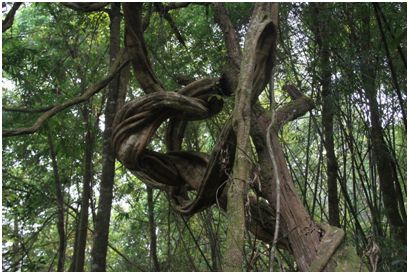Lianas comprise 25% of the woody species composition in tropical forests. They are often considered to be extremely efficient in water transport, and they may exhibit large time lags due to their extremely long stems, wide vessels and large volume of parenchyma in the stem. However, it has rarely been studied whether stored water functions in their daily water use, despite their increasing roles in the carbon and water dynamics of tropical forests caused by their increasing abundance. It has been revealed that time lag durations may be closely related to stem water storage. Therefore, comparison of the timing of sap flow in basal stem and branches of trees is widely used to estimate the contribution of internal water storage to daily water transpiration.
Researchers from Plant Eco-physiology Group of Xishuangbanna Tropical Botanical Garden (XTBG) assumed that the duration of time lags between the basal and upper stem sap flow was a proxy for the capacity of water storage to supply water to transpiration. They examined water use for transpiration of lianas and co-occurring trees in four forests (tropical seasonal forest, karst forest, flood plain forest and savanna forest) during a wet season. They established a 30×50m study plot in each forest, which involved 45 individuals (19 lianas and 26 trees) representing 27 species from 19 families. The researchers asked what factors affected the duration of time lags if lianas used stored water in daily transpiration. They then asked if stored water use contributed equally to transpiration for lianas and trees.
The study found that lianas had significantly higher saturated water content (SWC) and much lower wood density than trees. A far greater proportion of trees had time lags than lianas. Much more liana individuals had no time lags; in contrast, most tree individuals had time lags. In general, lianas tended to have shorter time lags than trees. Across trees and lianas, time lag duration increased with diurnal maximum changeable volumetric water content but was independent of the body size, path length, wood density and saturated water content. The results suggested that in most lianas, internal stem water storage contributed little to daily water budget, while trees may rely more on stored water in the stem.
The study entitled “Time lags between crown and basal sap flows in tropical lianas and co-occurring trees” has been published online in Tree Physiology.
Key words
Tropical lianas, trees, transpiration, water content, water storage, time lag
Contact
CHEN Yajun Ph.D
Key Laboratory of Tropical Forest Ecology, Xishuangbanna Tropical Botanical Garden, Chinese Academy of Sciences, Mengla, Yunnan 666303, China
Tel: 86 691 8713195
E-mail: chenyj@xtbg.org.cn

Tropical woody vines and co-occurring trees (Image by CHEN Yajun)

